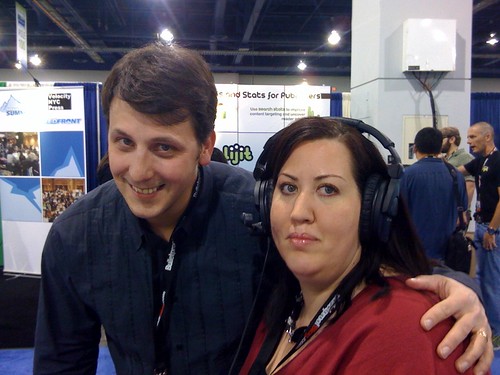Cross-posted on Powered's blog
Yup. It's been a few week's since we last posted our team's weekly social marketing links. As some of you know, I try and do a weekly digest of the links that my team (marketing, sales and product) come up with for our recurring staff meeting. Unfortunately, (work) life just gets in the way sometimes. Here's what we've got for this week:
Beth Lopez (Marketing)
Found
How to Do Social Marketing in Heavily Regulated Industries to be an interesting read on how regulated industries such as Financial Services, Healthcare and Pharma should tap into social marketing and how best to do it. The thinking is that since social marketing is a “pull” technique and not a “push” technique (where traditional regulations apply), advertisers and marketers in regulated industries should focus on…wait for it…wait for it…listening to consumers on social networks to gather research and insight (doesn’t everyone say that these days?). The author also goes on to state that for pharma (look in comments), marketers should be thinking about conversations around the disease versus the actual drugs (which is where they can get into trouble). All in all, an interesting perspective.
DP Rabalais (Marketing)
This article from Adweek,
The Revolution Will Be Mobile, talks about how the worldwide adoption of mobile phones (61% of the world's population has access to a mobile phone) is influencing how marketers connect with consumers. Mobile Internet usage in the U.S. has more than doubled in barely two years, and mobile communities are emerging.
According to the article, "For a brand that would like to learn more about what its customers and potential customers want, social networks via mobile are the perfect platform with massive scale. The Japanese mobile community "Mobage Town," for example, includes 12 million people. Anyone who wants to can listen in or join discussions, and anyone who wants to sell a product or service is enabled to do so."
Bill Fanning (BizDev)
This week’s post was written by
Francois Gossieaux titled,
Why Brand Communities Don’t Exist. Notice he refers to “Brand” communities, not “Branded” communities. To be clear, when we say “Branded” communities we are referring to where the community is hosted (on the brands site as opposed to Facebook or other external communities) not to the Brand being the topic of the community.
Francois makes a very important point (one that we at Powered built a business on) that people don’t participate in branded communities simply because they like the brand and enjoy their products. They participate because they are passionate about the lifestyle associated with the brand. The community gives them a place to get valuable information, interact with other people with similar interests and engage with the company. He notes several examples like the communities hosted by Harley, Jeep, Mini Cooper and Fiskars….we could add several others as well.
Good post!
Doug Wick (BizDev)
[Okay, so Doug has been up to his eyeballs with RFP's, contracts and keeping his blogging hat on. So I'm going to include his most recent post on Powered as his entree of the week...]
Almost anyone who knows anything about interfacing with customers or prospective customers through the Networks (Facebook, Twitter, et al.) will tell you that you should start by listening.
So most marketers' first step is to set up a monitoring tool (maybe expensive, maybe as simple as a free keyword search on Twitter). Then, the first experience that almost every media marketer (or marketer, period) has after listening to the Networks for a bit is that the brand, product, or company they are representing will be mentioned. When this happens (“just bought a Honda at Carmax, great experience!”), it will make a positive and socially important impression on everyone who views it. This is exciting because it is essentially a free media placement, a nugget of gold dropped into people's news or Twitter feeds that didn’t cost you anything! This type of mention is often called “earned media,” earned because your company created a great customer experience that made someone tell their friends.
Jay MacIntosh (BizDev)
The Tribalization of Business Study (2009) by Deloitte and Beeline Labs.
Disclaimer: I don’t understand why anyone would refer to a group of people sharing an interest as tribes. I’ve always thought of tribes, similar to the clans of my Scottish background, as having to do with ancestry (i.e. people who came before us like forefathers/mothers). Do we really need to “dress-up” social media to get more people to pay attention to the significance of the online social phenomena? I guess so…
Anyhow, this recently released study from Deloitte paints a broad picture of where companies are at with their adoption of social media. As suspected, backed up by the conversations I’ve had with over 50 such companies the past several months, I’d say they’re at the preadolescent stage. Characterized by - beginning to care somewhat about if/how they fit in, have a rough idea of some goals, more focused on the future, beginning to care about how their appearance, etc.
I won’t go into the details (which you’ll get in the 10 minutes it takes you to look through the 28 slides), but here are a couple of the most interesting findings:
- It looks like only about 20% of these communities have members in the thousands.
- Approximately 60% of their company’s oldest community have been in existence for less than 1 year.
- Stated goals (i.e. what they want to achieve) and metrics (i.e. how they keep score) are out of whack.
- 45% plan to increase their investment in social media and online communities while only 6% plan to decrease investment.
Don Sedota (Product)
Good perspectives by
Jeremiah Owyang on the
Google/Twitter/Bing deal announced earlier last week. Basically Google and Bing will now start incorporating URL tweets/re-tweets and the influence/reach of corresponding tweeters into search rankings (i.e., consumers now have a direct impact on search rankings).
His key takeaways include:
- Companies must focus even more on listening to make sure PR flare ups and the like on Twitter are quickly extinguished
- It’s becoming increasingly important for companies offer easy social sharing (e.g., via Twitter) for site content. (Also of note is that Facebook will be offering public status updates to Bing so sharing via FB/FBC becomes more valuable to companies from a search results perspective)
- Companies must continue to develop in-house influencers on Twitter in order to juice the search rankings of corresponding tweets (URLs)
How about you? Any good articles/posts/research to share? We're always looking for fresh inspiration.
 You all know that I love to do webinars. Well, there's a very cool one coming up next month on Thursday, November 12 (2 PM CT) with one of my friends (and sometimes podcast companion), Jill Griffin. Jill is a local Austinite and a three time author. Her main focus is customer loyalty. We'll also be joined by client and social savant, Allen Silkin of Atkins Nutritionals.
You all know that I love to do webinars. Well, there's a very cool one coming up next month on Thursday, November 12 (2 PM CT) with one of my friends (and sometimes podcast companion), Jill Griffin. Jill is a local Austinite and a three time author. Her main focus is customer loyalty. We'll also be joined by client and social savant, Allen Silkin of Atkins Nutritionals.




















